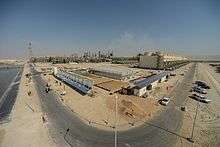Michael Pawlyn
Michael Pawlyn (born 30 September 1967) is a British architect noted[1] for his work in the field biomimetic architecture and innovation. He was part of the principal team of architects that conceived and designed The Eden Project[2] and is a regular keynote speaker at events on innovation and environmental sustainability. His best selling RIBA book Biomimicry in Architecture[3] was published in 2011 and a revised second edition, with a foreword by Ellen MacArthur, was published in 2016. He was one of the three founders of The Sahara Forest Project[4] - a way of supplying fresh water, food and renewable energy in arid conditions - and remains actively involved as a Founding Partner and Design Manager.
Michael Pawlyn | |
|---|---|
| Born | 30 September 1967 |
| Nationality | British |
| Education | BSc (Hons) Architecture, BArch |
| Alma mater | University College London University of Bath |
| Occupation | Architect |
| Partner(s) | Kelly Hill |
| Children | 2 |
| Website | https://exploration-architecture.com |
Career


After graduating in Architecture from The Bartlett, University College London, Pawlyn worked in London and Japan before returning to complete his studies at the University of Bath. He worked briefly as a researcher on television documentaries before joining Haworth Tompkins Architects. In 1997 Michael Pawlyn became part of the Grimshaw Architects' team to work on the Eden Project. This innovative scheme, conceived by Tim Smit, radically transformed a Kaolinite pit into a complex of adjoining Biomes that created sustainable environments for Rainforest and Mediterranean plant species.
In 2007 he established Exploration Architecture to develop work that employs biomimicry[5] as a guiding principal and brings together three lifelong passions - biology, design and the environment.
At TED Salon London, November 2011, Michael Pawlyn became one of the small number of architects to have a talk posted to TED. His presentation, in which he describes how biomimicry could help transform architecture and society, has been viewed over 1.5 million times.
Exploration Architecture’s work was exhibited in a solo exhibition, at The Architecture Foundation in 2014.[6]
Selected Projects
Boat for the Plastiki Expedition:[7] This project, designed with client David de Rothschild, explored Cradle to CradleTM ideas to highlight solutions to plastic pollution in the ocean.
The Sahara Forest Project:[8] demonstrates how biomimicry can help address a range of challenges by employing three components - saltwater cooled greenhouses, concentrated solar power (CSP) and desert revegetation technologies. Collectively these elements provide fresh water, land regeneration, the sequestering of carbon in soils, the closing the nutrient cycle and provides employment in deprived areas.[9]
The Biomimetic Office:[10] A sustainable office building designed with Yaniv Peer of Exploration, Arup Research & Development, Mace Cost Consultants and Professor Julian Vincent[11]
The Mountain Data Centre: A concept for ultra-low energy data centre based on principles of efficient branching systems in biology referred to as Murray’s Law
Personal
Michael lives in London with his partner, photographer Kelly Hill,[12] and their two children.
Bibliography
Books:
· Michael Pawlyn (2011) Biomimicry in Architecture (first edition) with a foreword by Jonathon Porritt, London, RIBA Publications
· Michael Pawlyn (2016) Biomimicry in Architecture (second edition) with a foreword by Dame Ellen MacArthur, London, RIBA Publications
Chapter in multi-authored book:
· Michael Pawlyn (2016) Ecosystems as a unifying model for cities and industry, The Ellen MacArthur Foundation (ed.) A New Dynamic 2: Effective systems in a circular economy,[13] Cowes, Ellen MacArthur Foundation Publishing, pp 63–85
References
- Thornhill, John (January 28, 2016). "Michael Pawlyn, the architect inspired by nature". Retrieved September 15, 2016 – via The Financial Times.
- Prospero (November 9, 2011). "The Q&A: Michael Pawlyn. Lessons of design learned from nature". Retrieved September 15, 2016 – via The Economist.
- Scott, Katie (February 22, 2012). "Biomimicry in architecture and the start of the Ecological Age". www.wired.co.uk. Wired. Retrieved September 15, 2016.
- Jha, Alok (September 2, 2008). "Seawater greenhouse to bring life to the desert". www.theguardian.com. The Guardian. Retrieved September 15, 2016.
- McKeag, Tom (March 4, 2014). "Portfolio, Exploration Architecture". Zygote Quarterly. 3 (10). Retrieved September 15, 2016.
- Glickfield, Elizabeth (March 4, 2014). "Designing with Nature". Domus. Retrieved September 15, 2016.
- "Plastiki expedition boat by exploration architecture for adventure ecology". www.dezeen.com. dezeen. July 22, 2010. Retrieved September 19, 2016.
- McKeag, Tom (November 11, 2014). "Case Study : Seeing the forest for the trees". www.zqjournal.org. zygote quarterly. Retrieved September 19, 2016.
- O'Connell, Sanjida (June 8, 2009). "Biomimicry: why the world is full of intelligent design". www.telegraph.co.uk. The Telegraph Media Group. Retrieved September 19, 2016.
- Rawlence, Peter (August 1, 2016). "Sustainable architecture: taking a leaf out of nature's book". Linkedin.com. Mega.online. Retrieved September 20, 2016.
- Vincent, Julian F V (August 22, 2006). "Biomimetics: its practice and theory". Journal of the Royal Society Interface. 3: 471–82. doi:10.1098/rsif.2006.0127. PMC 1664643. PMID 16849244.
- Thornhill, John (January 28, 2016). "Michael Pawlyn, the architect inspired by nature". www.ft.com. The Financial Times Ltd. Retrieved September 19, 2016.
- Franconi, Ellen (February 25, 2016). A New Dynamic 2: Effective systems in a circular economy. Cowes: Ellen MacArthur Foundation Publishing. pp. 63–85. ISBN 0992778441.